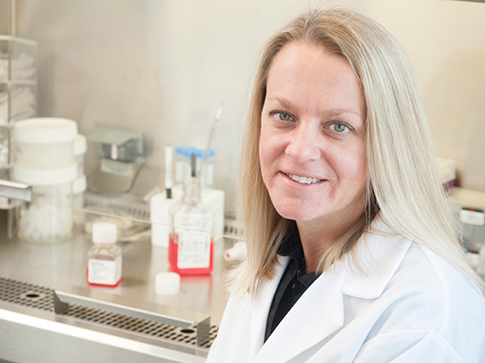Kasinski receives grants to improve gene therapy for cancer
12-08-2017

Purdue professor receives grants to improve gene therapy for cancer
Posted December 7th, 2017 by Purdue
Andrea Kasinski in her lab at Bindley Bioscience Center. Download image
WEST LAFAYETTE, Ind. — Andrea Kasinski, an assistant professor of biology in Purdue University’s College of Science, has been awarded grants to improve microRNA therapeutics for cancer by the American Cancer Society and the National Institutes of Health.
Small, non-coding RNAs, called microRNAs, are often lost during the formation of tumors and restoring critical RNAs is known to fight cancer. More than 2,000 microRNAs have been identified in the human genome, and one has proven to be particularly effective in treating cancer: miR-34a. It was the first microRNA to enter clinical trial, and although the trial was halted due to problems with toxicity, Kasinski is working hard to make it safer.
With the support of the National Institutes of Health grant, Kasinski’s lab tested miR-34a in combination with every other known microRNA, and they identified 10 that significantly enhance its tumor-suppressing capability. They’ve just started to identify the targets of those microRNAs to figure out the molecular reasoning for their cooperative effect, which they hope will bring them closer to better understanding microRNA biology on a broader scale.
The same grant will support the development of a new method for delivering microRNAs to tumors: completely unprotected. RNAs are inherently unstable and are often degraded in the bloodstream during transport. In the past, it was assumed that to use them as a therapy, they would need to be protected on their way to the tumor. Lipids are often used to protect microRNAs, but they can be toxic, which might be why miR-34a failed its first time in clinical trial. Rather than using a lipid to protect the microRNA, Kasinski’s lab members conjugated it to a folate (creating a FolamiR), and the method has been successful in shrinking tumors.
The American Cancer Society grant will fund an effort to improve that technique. Kasinski hopes that adding a small molecule - ionophore - to the FolamiR will help get more of the microRNA out of the endosome to perform its job.
“The FolamiR gets engulfed by the endosome of the cancer cell, and a lot of times most of it doesn’t get out. We’ve been able to get some of it out, but if we do better we’ll be able to reduce dosing and have better efficacy,” Kasinski said. “We could also use this mechanism to improve other drugs because so many get trapped in the endosome.”
Both research projects will use mouse models that have the most common genetic causes of lung cancer in humans: activation of the K-RAS gene and mutation of TP53.
Grant RSG-17-198-01 - RMC from the American Cancer Society will provide $792,000 from 2012 to 2021. Grant 1R01CA205420-01A1 from the National Institutes of Health will provide about $1.75 million from 2017 to 2022.